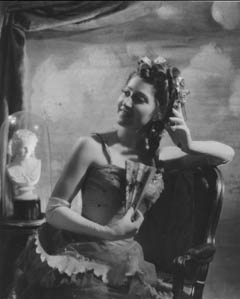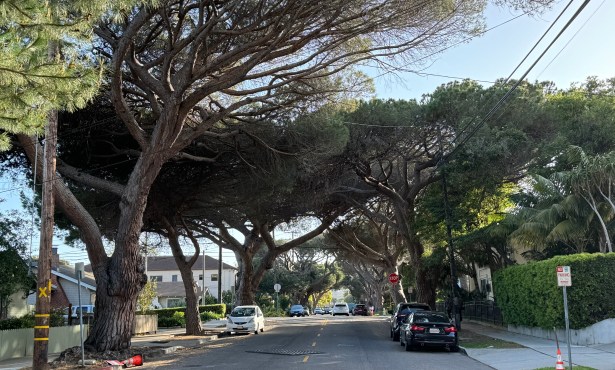Ernestina Franceschi Fenzi 1918-2007

Ernestina Franceschi Fenzi was a proud Santa Barbara native who spoke English without a “Tuscan accent.” World War II ended her dream of making a career out of dancing, even though she already had quite a list of illustrious credits to her name. Around that time, a young man who saw her perform in London, James Grant Forbes Jr., romantically courted Ernestina and followed her back to Italy. After he fell ill, she escorted him back to the U.S., where he was hospitalized. His sisters continued to tend to her medical needs until their deaths. Tina often reminisced, “James was very much in love with me.”
Ernestina was always a romantic and loved classical ballet in the Russian tradition. She loathed modern trends of stick-like ballet acrobatics, finding them vulgar, and detested skeletal bodies. She wanted to see grace in the arms and neck, suppleness of the back.

Her dream was to choreograph and to have her own school and company. When she returned to the U.S. by steamer ship with her beloved rescue cat, Perejil (now buried under a shade tree in the late Reginald Faletti’s garden), she choreographed in the Los Angeles area. She formed the friendship of her lifetime with brilliant dancer Gene Marinaccio, who states to this day that Tina pushed him to his limits as a dancer, even at times when he did not believe he could do it. He says her spirit is still within him.
Tina moved here and formed her own school, consisting predominantly of dancers whom she had trained from childhood. Occasionally, she invited guest artists. I was lucky enough to be one of Tina’s dancers. When she was short of male dancers for a production, she went to East Beach and approached a handsome surfer with an offer of a crash course in partnering to become a prince on stage. They never refused her.
There was nothing contemporary about Ernestina’s methods. This was pure classical ballet. She took pride in her ability to make us “get off the floor.” We performed at the Lobero Theatre, in Los Angeles, at UCSB, on the lawn and under the arches of the Brooks campus, on the Mission and Courthouse steps at Fiesta, at the Ojai Festival, and at private estates.
Miss Fenzi-as she was always called-had already lost a number of students to famous professional companies, but it wasn’t until real estate prices rose out of control that her dream was truly shattered. The Riviera campus-where her studio was located-sold, rent quadrupled, and she was forced to take a cramped studio downtown. Most of her students left. Other teachers, backed by a lot of money, had come to town. Ernestina was forced to leave.
The beautiful Tuscan village of Volterra awaited her. The residents there built her a studio that surpassed the one she had lost, landscaped by fabulous gardens, but cash was slight once again. She often said, “They expect me to live on air.” Ten years or so later, when Tina returned to Santa Barbara, she was grateful for Section 8 housing at Villa La Cumbre. She took up oil painting at Adult Education and bingo at Villa La Cumbre. She was fortunate to have the aid of organizations that contributed their services to her, but she was stubborn about accepting help. Although many were concerned about reports that Tina lacked proper medical care, personal care, and nutrition, no one could force help on Tina. During the six months before her hospitalization, she had many falls, but refused help. There were no broken bones, but after the umpteenth fall, she never walked again. She died approximately two months later.
During those last two months, she stated that only two people mattered to her: Joan (Warren Fenzi’s daughter), her cousin, who tirelessly stayed by Ernestina’s bedside and supervised her medical care; and “Jacqueline” (she spoke to me always in the third person at the end), a friend who helped Miss Fenzi for many years with her selective food requests and took her regularly to the Coral Casino for her favorite hamburger and a much needed Jacuzzi for her arthritis-not to mention the ocean. She would stand at the tide’s edge for hours, raise her arms to the sky as if in awe of the universe, and then turn around grinning at me. But the club closed, and the bingo room burned down. She became confined and the arthritis worsened.
Much as the world Tina loved was slowly taken from her, an appreciation of natural beauty, grace, and sincere kindness, which never failed to lift her spirits, has left our society. Ernestina was upset by the ability of new money to roll into town and bulldoze what merited preservation-all in the name of profit. Her devout Catholicism saved her, along with her love of cats, art, and nature, her memories of the original Franceschi home, and her love for those who never abandoned her. Miss Fenzi’s life was full of tragedy and losses, but no one could destroy her aristocratic pride, memories, and love.
When Tina could no longer speak, I suggested she dream she was dancing her favorite role. A huge grin spread across her face as she made a graceful corps de bras motion all the way through to her long fingers.



